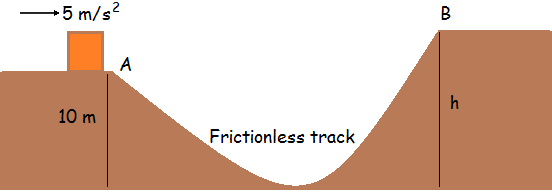Mechanics - 6

A block starts with a velocity of at , which is at a height , ends just reaching , which is at a height . If all the surfaces are frictionless, find . Take .
Try my World of Physics to solve many problems like this one.
The answer is 11.25.
This section requires Javascript.
You are seeing this because something didn't load right. We suggest you, (a) try
refreshing the page, (b) enabling javascript if it is disabled on your browser and,
finally, (c)
loading the
non-javascript version of this page
. We're sorry about the hassle.
Neglect all friction and air resistance, by conservation of energy , the energy of the block at point B equals to that at the initial position of A , that is:
E B m g h + 2 1 m v B 2 g h + 0 ⟹ h = E A = m g h A + 2 1 m v A 2 = 1 0 g + 2 5 2 = 1 0 + 2 0 2 5 = 1 1 . 2 5 where h A is the height at the block at point A and v A , v B are the respective velocities at A and B .